二苯甲酮作用
- 格式:doc
- 大小:34.00 KB
- 文档页数:3
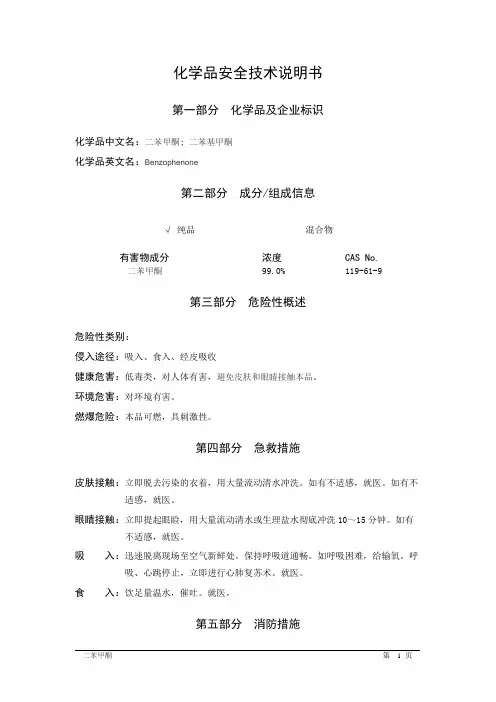
化学品安全技术说明书第一部分化学品及企业标识化学品中文名:二苯甲酮;二苯基甲酮化学品英文名:Benzophenone第二部分成分/组成信息√纯品混合物有害物成分浓度CAS No.二苯甲酮99.0% 119-61-9第三部分危险性概述危险性类别:侵入途径:吸入、食入、经皮吸收健康危害:低毒类,对人体有害,避免皮肤和眼睛接触本品。
环境危害:对环境有害。
燃爆危险:本品可燃,具刺激性。
第四部分急救措施皮肤接触:立即脱去污染的衣着,用大量流动清水冲洗。
如有不适感,就医。
如有不适感,就医。
眼睛接触:立即提起眼睑,用大量流动清水或生理盐水彻底冲洗10~15分钟。
如有不适感,就医。
吸入:迅速脱离现场至空气新鲜处。
保持呼吸道通畅。
如呼吸困难,给输氧。
呼吸、心跳停止,立即进行心肺复苏术。
就医。
食入:饮足量温水,催吐。
就医。
第五部分消防措施危险特性:易燃,遇明火、高热或与氧化剂接触,有引起燃烧爆炸。
与氧化剂能发生强烈反应。
有害燃烧产物:一氧化碳、二氧化碳。
灭火方法:抗溶性泡沫、干粉、二氧化碳、砂土。
灭火注意事项及措施:尽可能将容器从火场移至空旷处。
喷水保持火场容器冷却,直至灭火结束。
处在火场中的容器若已变色或从安全泄压装置中产生声音,必须马上撤离。
第六部分泄漏应急处理应急行动:隔离泄漏污染区,周围设警告标志,建议应急处理人员戴好防毒面具,穿化学防护服。
不要直接接触泄漏物,小心扫起,收集运至废物处理场所处置。
如大量泄漏,收集回收或无害处理后废弃。
第七部分操作处置与储存操作注意事项:密闭操作,全面通风。
操作人员必须经过专门培训,严格遵守操作规程。
储存注意事项:储存于阴凉、干燥、通风的库房。
远离火种、热源。
避免光照。
包装密封。
应与氧化剂、酸类、碱类、食用化学品分开存放,切忌混储。
配备相应品种和数量的消防器材。
储区应备有合适的材料收容泄漏物。
第八部分接触控制/个体防护接触限值:监测方法:工程控制:生产过程密闭,全面通风。
提供安全淋浴和洗眼设备。

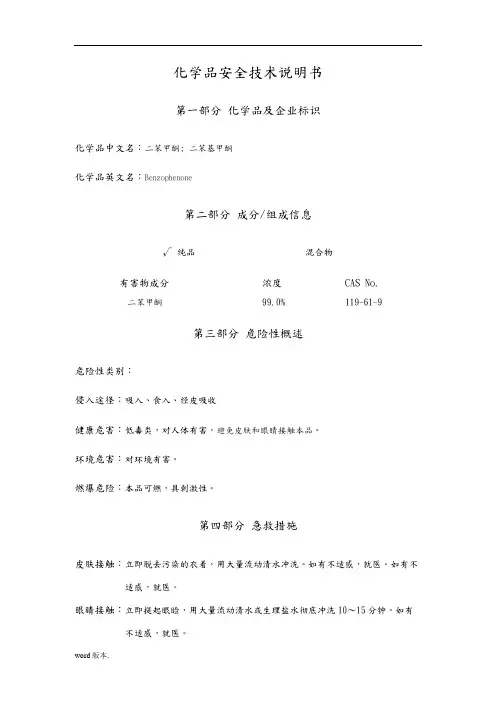
化学品安全技术说明书第一部分化学品及企业标识化学品中文名:二苯甲酮;二苯基甲酮化学品英文名:Benzophenone第二部分成分/组成信息√纯品混合物有害物成分浓度CAS No.二苯甲酮99.0% 119-61-9第三部分危险性概述危险性类别:侵入途径:吸入、食入、经皮吸收健康危害:低毒类,对人体有害,避免皮肤和眼睛接触本品。
环境危害:对环境有害。
燃爆危险:本品可燃,具刺激性。
第四部分急救措施皮肤接触:立即脱去污染的衣着,用大量流动清水冲洗。
如有不适感,就医。
如有不适感,就医。
眼睛接触:立即提起眼睑,用大量流动清水或生理盐水彻底冲洗10~15分钟。
如有不适感,就医。
吸入:迅速脱离现场至空气新鲜处。
保持呼吸道通畅。
如呼吸困难,给输氧。
呼吸、心跳停止,立即进行心肺复术。
就医。
食入:饮足量温水,催吐。
就医。
第五部分消防措施危险特性:易燃,遇明火、高热或与氧化剂接触,有引起燃烧爆炸。
与氧化剂能发生强烈反应。
有害燃烧产物:一氧化碳、二氧化碳。
灭火方法:抗溶性泡沫、干粉、二氧化碳、砂土。
灭火注意事项及措施:尽可能将容器从火场移至空旷处。
喷水保持火场容器冷却,直至灭火结束。
处在火场中的容器若已变色或从安全泄压装置中产生声音,必须马上撤离。
第六部分泄漏应急处理应急行动:隔离泄漏污染区,周围设警告标志,建议应急处理人员戴好防毒面具,穿化学防护服。
不要直接接触泄漏物,小心扫起,收集运至废物处理场所处置。
如大量泄漏,收集回收或无害处理后废弃。
第七部分操作处置与储存操作注意事项:密闭操作,全面通风。
操作人员必须经过专门培训,严格遵守操作规程。
储存注意事项:储存于阴凉、干燥、通风的库房。
远离火种、热源。
避免光照。
包装密封。
应与氧化剂、酸类、碱类、食用化学品分开存放,切忌混储。
配备相应品种和数量的消防器材。
储区应备有合适的材料收容泄漏物。
第八部分接触控制/个体防护接触限值:监测方法:工程控制:生产过程密闭,全面通风。
提供安全淋浴和洗眼设备。
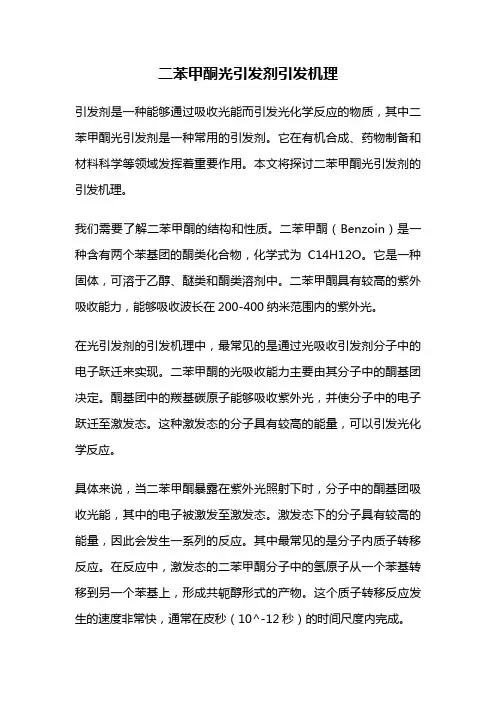
二苯甲酮光引发剂引发机理引发剂是一种能够通过吸收光能而引发光化学反应的物质,其中二苯甲酮光引发剂是一种常用的引发剂。
它在有机合成、药物制备和材料科学等领域发挥着重要作用。
本文将探讨二苯甲酮光引发剂的引发机理。
我们需要了解二苯甲酮的结构和性质。
二苯甲酮(Benzoin)是一种含有两个苯基团的酮类化合物,化学式为C14H12O。
它是一种固体,可溶于乙醇、醚类和酮类溶剂中。
二苯甲酮具有较高的紫外吸收能力,能够吸收波长在200-400纳米范围内的紫外光。
在光引发剂的引发机理中,最常见的是通过光吸收引发剂分子中的电子跃迁来实现。
二苯甲酮的光吸收能力主要由其分子中的酮基团决定。
酮基团中的羰基碳原子能够吸收紫外光,并使分子中的电子跃迁至激发态。
这种激发态的分子具有较高的能量,可以引发光化学反应。
具体来说,当二苯甲酮暴露在紫外光照射下时,分子中的酮基团吸收光能,其中的电子被激发至激发态。
激发态下的分子具有较高的能量,因此会发生一系列的反应。
其中最常见的是分子内质子转移反应。
在反应中,激发态的二苯甲酮分子中的氢原子从一个苯基转移到另一个苯基上,形成共轭醇形式的产物。
这个质子转移反应发生的速度非常快,通常在皮秒(10^-12秒)的时间尺度内完成。
二苯甲酮的质子转移反应是光引发剂引发光化学反应的关键步骤。
质子转移反应使得二苯甲酮分子中形成了高度活性的共轭醇形式,这种形式具有较高的反应活性,能够与其他分子发生反应。
例如,共轭醇形式的二苯甲酮可以与另一个二苯甲酮分子发生反应,形成二苯甲酮的二聚体。
这种反应被称为二聚反应,是二苯甲酮光引发剂引发的光化学反应中常见的反应类型。
除了质子转移反应和二聚反应外,二苯甲酮还可以引发其他类型的光化学反应,例如氧化反应和还原反应。
这些反应的发生通常需要外部的受体或给体分子的参与。
通过与其他分子发生反应,二苯甲酮的激发态能量得以释放,从而引发光化学反应的进行。
总结起来,二苯甲酮光引发剂通过吸收紫外光引发分子内质子转移反应和其他光化学反应。
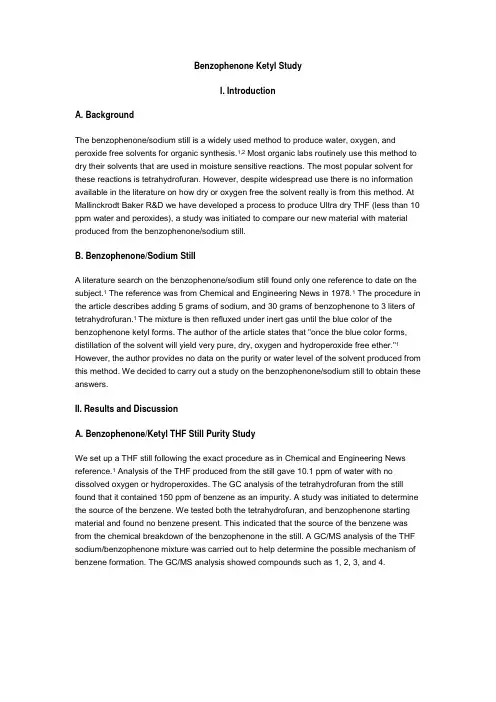
Benzophenone Ketyl StudyI. IntroductionA. BackgroundThe benzophenone/sodium still is a widely used method to produce water, oxygen, and peroxide free solvents for organic synthesis.1,2 Most organic labs routinely use this method to dry their solvents that are used in moisture sensitive reactions. The most popular solvent for these reactions is tetrahydrofuran. However, despite widespread use there is no information available in the literature on how dry or oxygen free the solvent really is from this method. At Mallinckrodt Baker R&D we have developed a process to produce Ultra dry THF (less than 10 ppm water and peroxides), a study was initiated to compare our new material with material produced from the benzophenone/sodium still.B. Benzophenone/Sodium StillA literature search on the benzophenone/sodium still found only one reference to date on the subject.1 The reference was from Chemical and Engineering News in 1978.1 The procedure in the article describes adding 5 grams of sodium, and 30 grams of benzophenone to 3 liters of tetrahydrofuran.1 The mixture is then refluxed under inert gas until the blue color of the benzophenone ketyl forms. The author of the article states that "once the blue color forms, distillation of the solvent will yield very pure, dry, oxygen and hydroperoxide free ether."1 However, the author provides no data on the purity or water level of the solvent produced from this method. We decided to carry out a study on the benzophenone/sodium still to obtain these answers.II. Results and DiscussionA. Benzophenone/Ketyl THF Still Purity StudyWe set up a THF still following the exact procedure as in Chemical and Engineering News reference.1 Analysis of the THF produced from the still gave 10.1 ppm of water with no dissolved oxygen or hydroperoxides. The GC analysis of the tetrahydrofuran from the still found that it contained 150 ppm of benzene as an impurity. A study was initiated to determine the source of the benzene. We tested both the tetrahydrofuran, and benzophenone starting material and found no benzene present. This indicated that the source of the benzene was from the chemical breakdown of the benzophenone in the still. A GC/MS analysis of the THF sodium/benzophenone mixture was carried out to help determine the possible mechanism of benzene formation. The GC/MS analysis showed compounds such as 1, 2, 3, and 4.These compounds are formed by some type of free radical reaction with phenyl radicals. The probable mechanism is the carbonyl phenyl group bond breaks forming phenyl radicals, and benzaldehyde. The benzaldehyde (5) then either undergoes reduction to benzyl alcohol (6), or further reaction with the phenyl free radicals.We carried out a test to determine if the benzaldehyde is reduced in thesodium/benzophenone still. Benzaldehyde (5) was added to THF in the presence of sodium, the mixture was then refluxed. We found that benzaldehyde (5) was reduced to the benzyl alcohol (6). Additional further GC/MS analysis was carried out to look for the benzaldehyde (5) and benzyl alcohol (6). Unfortunately, neither benzyl alcohol nor benzaldehyde was detected. One possible explanation is the benzaldehyde and benzyl alcohol rapidly undergo further reactions in the sodium/benzophenone still to prevent their detection. For example, the reaction of benzaldehyde with phenyl radicals could have resulted in the formation of compounds (1), and (2). Another possible pathway would be rapid polymerization of these compounds.B. Effect of Water on the Benzophenone KetylThe next study was to determine what effect water had on the decomposition of the benzophenone ketyl. The benzophenone ketyl was produced in THF at a concentration of 630 ppm. The loss of blue color would indicate decomposition of the ketyl. Titration of the ketyl with water showed that a full 100 mol% of water was required to quench the blue color. Thisindicates that water reacts in a simple one to one mole ratio with the ketyl. Therefore, the blue color of the ketyl does not necessary indicate super dry conditions.For example in the typical procedure the ketyl is produced at a concentration of 6311 ppm in THF. When a small amount of water is added to a sample of this mixture to increase the water concentration, the solution will still remain blue since until all of the ketyl decomposed. Thus it would be possible to have a concentration of 100 ppm water in the solvent, and if the ketyl was not used up, it would still have the blue ketyl color.C. Effect of Oxygen on Benzophenone KetylThe final study was to determine how sensitive the ketyl was to oxygen. An experiment was carried out where the ketyl was titrated with oxygen. We found that the color was quenched with 8 mole% of oxygen. This data shows that the benzophenone ketyl reacts catalytically with oxygen and not on a one to one mole ratio as water does. Thus the benzophenone ketyl is much more sensitive to oxygen than to water.II. ConclusionDrying and purification of THF and other solvents is a widely used practice in many labs. Solvent produced from the sodium/benzophenone still is believed to be of the highest quality. Despite the fact there was no real data on the actual quality of the solvent. This belief has been passed down from lab worker to lab worker as the method of choice for producing anhydrous solvents for organometallic synthesis. Our studies have shown that while the THF produced from the still is free of oxygen and low in water (10 ppm), it does contain benzene contamination. The presence of benzene could interfere with critical applications. Additionally, the blue color of the benzophenone ketyl is not a very reliable indication of anhydrous conditions. These results are very significant since they provide the chemist real information on the purity of the tetrahydrofuran produced from the sodium/benzophenone still. In contrast our new THF is oxygen free, contains less that 5 ppm of peroxides. Our water content is less than 10 ppm and our material is free of impurities such as benzene. This material is available in bottles and CYCLE-TAINERs in sizes up to 215L.III. References1. Schwartz, A.M. Chem. Eng. News 1978, (56) 24, 88.2. Perrin, D.D.; Armarego, W.L.F "Purification Of Laboratory Chemicals" Pergamon Press: New York, 1980.© 2000 by Mallinckrodt Baker Inc. All Rights Reserved.Literature # 8882R (2/99)。

二苯甲酮MSDS化学品安全技术说明书第一部分化学品及企业标识化学品中文名:二苯甲酮;二苯基甲酮化学品英文名:Benzophenone第二部分成分/组成信息√纯品混合物有害物成分浓度CAS No.二苯甲酮99.0% 119-61-9第三部分危险性概述危险性类别:侵入途径:吸入、食入、经皮吸收健康危害:低毒类,对人体有害,避免皮肤和眼睛接触本品。
环境危害:对环境有害。
燃爆危险:本品可燃,具刺激性。
第四部分急救措施皮肤接触:立即脱去污染的衣着,用大量流动清水冲洗。
如有不适感,就医。
如有不适感,就医。
眼睛接触:立即提起眼睑,用大量流动清水或生理盐水彻底冲洗10~15分钟。
如有不适感,就医。
吸入:迅速脱离现场至空气新鲜处。
保持呼吸道通畅。
如呼吸困难,给输氧。
呼吸、心跳停止,立即进行心肺复苏术。
就医。
食入:饮足量温水,催吐。
就医。
第五部分消防措施危险特性:易燃,遇明火、高热或与氧化剂接触,有引起燃烧爆炸。
与氧化剂能发生强烈反应。
有害燃烧产物:一氧化碳、二氧化碳。
灭火方法:抗溶性泡沫、干粉、二氧化碳、砂土。
灭火注意事项及措施:尽可能将容器从火场移至空旷处。
喷水保持火场容器冷却,直至灭火结束。
处在火场中的容器若已变色或从安全泄压装置中产生声音,必须马上撤离。
第六部分泄漏应急处理应急行动:隔离泄漏污染区,周围设警告标志,建议应急处理人员戴好防毒面具,穿化学防护服。
不要直接接触泄漏物,小心扫起,收集运至废物处理场所处置。
如大量泄漏,收集回收或无害处理后废弃。
第七部分操作处置与储存操作注意事项:密闭操作,全面通风。
操作人员必须经过专门培训,严格遵守操作规程。
储存注意事项:储存于阴凉、干燥、通风的库房。
远离火种、热源。
避免光照。
包装密封。
应与氧化剂、酸类、碱类、食用化学品分开存放,切忌混储。
配备相应品种和数量的消防器材。
储区应备有合适的材料收容泄漏物。
第八部分接触控制/个体防护接触限值:监测方法:工程控制:生产过程密闭,全面通风。
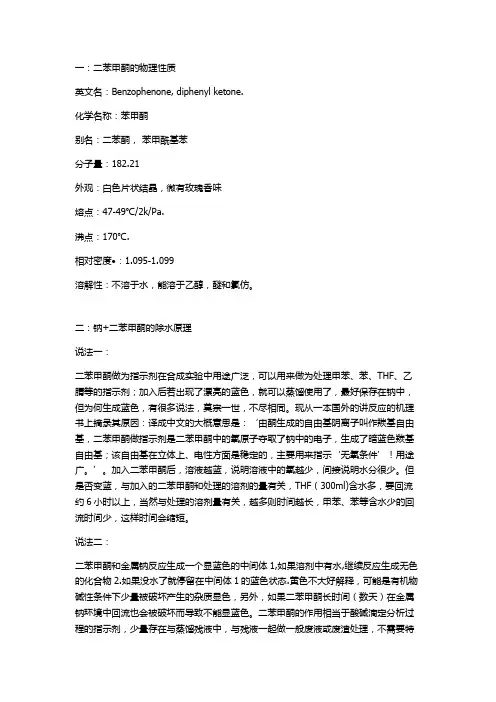
一:二苯甲酮的物理性质英文名:Benzophenone, diphenyl ketone.化学名称:苯甲酮别名:二苯酮,苯甲酰基苯分子量:182.21外观:白色片状结晶,微有玫瑰香味熔点:47-49℃/2k/Pa.沸点:170℃.相对密度•:1.095-1.099溶解性:不溶于水,能溶于乙醇,醚和氯仿。
二:钠+二苯甲酮的除水原理说法一:二苯甲酮做为指示剂在合成实验中用途广泛,可以用来做为处理甲苯、苯、THF、乙腈等的指示剂;加入后若出现了漂亮的蓝色,就可以蒸馏使用了,最好保存在钠中,但为何生成蓝色,有很多说法,莫宗一世,不尽相同。
现从一本国外的讲反应的机理书上摘录其原因:译成中文的大概意思是:‘由酮生成的自由基阴离子叫作羰基自由基,二苯甲酮做指示剂是二苯甲酮中的氧原子夺取了钠中的电子,生成了暗蓝色羰基自由基;该自由基在立体上、电性方面是稳定的,主要用来指示‘无氧条件’!用途广。
’。
加入二苯甲酮后,溶液越蓝,说明溶液中的氧越少,间接说明水分很少。
但是否变蓝,与加入的二苯甲酮和处理的溶剂的量有关,THF(300ml)含水多,要回流约6小时以上,当然与处理的溶剂量有关,越多则时间越长,甲苯、苯等含水少的回流时间少,这样时间会缩短。
说法二:二苯甲酮和金属钠反应生成一个显蓝色的中间体1,如果溶剂中有水,继续反应生成无色的化合物2.如果没水了就停留在中间体1的蓝色状态.黄色不大好解释,可能是有机物碱性条件下少量被破坏产生的杂质显色,另外,如果二苯甲酮长时间(数天)在金属钠环境中回流也会被破坏而导致不能显蓝色。
二苯甲酮的作用相当于酸碱滴定分析过程的指示剂,少量存在与蒸馏残液中,与残液一起做一般废液或废渣处理,不需要特殊的处理方式。
变蓝色是因为二苯甲酮在钠表面被还原为自由基,其对水和氧气都敏感,没有水自然就显蓝色了。
但是反应过程中钠表面被NaOH覆盖或二苯甲酮消耗过多,无法继续生成自由基就不能变蓝了。
三:钠+二苯甲酮的除水步骤1:检验有无过氧化物方法一:为此取少量试剂(乙醚,四氢呋喃)与等体积的2%碘化钾溶液,加入几滴稀盐酸一起振摇,若能使淀粉溶液呈紫色或蓝色,即证明有过氧化物存在。
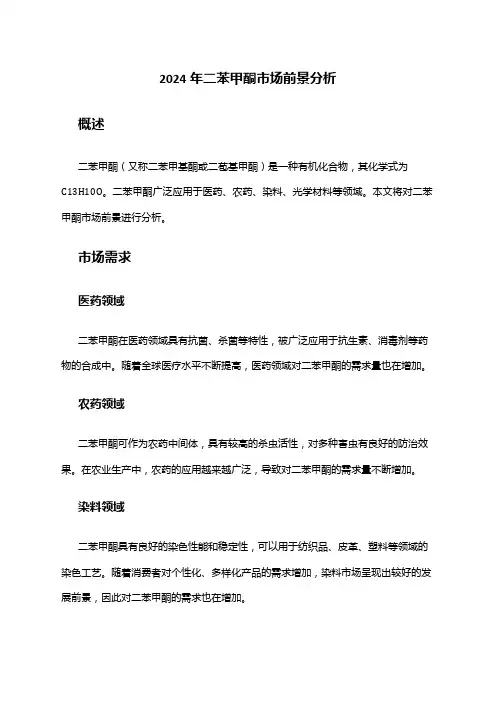
2024年二苯甲酮市场前景分析概述二苯甲酮(又称二苯甲基酮或二苞基甲酮)是一种有机化合物,其化学式为C13H10O。
二苯甲酮广泛应用于医药、农药、染料、光学材料等领域。
本文将对二苯甲酮市场前景进行分析。
市场需求医药领域二苯甲酮在医药领域具有抗菌、杀菌等特性,被广泛应用于抗生素、消毒剂等药物的合成中。
随着全球医疗水平不断提高,医药领域对二苯甲酮的需求量也在增加。
农药领域二苯甲酮可作为农药中间体,具有较高的杀虫活性,对多种害虫有良好的防治效果。
在农业生产中,农药的应用越来越广泛,导致对二苯甲酮的需求量不断增加。
染料领域二苯甲酮具有良好的染色性能和稳定性,可以用于纺织品、皮革、塑料等领域的染色工艺。
随着消费者对个性化、多样化产品的需求增加,染料市场呈现出较好的发展前景,因此对二苯甲酮的需求也在增加。
光学材料领域二苯甲酮具有较高的光学透明度和稳定性,被广泛应用于光学材料的制备中,如光学镜片、光学薄膜等。
随着科技的不断发展,光学材料市场持续增长,对二苯甲酮的需求也在增加。
市场竞争情况目前,二苯甲酮市场存在一定的竞争,主要竞争企业包括国内外的化工公司和医药公司。
这些企业通过提高产品质量、降低成本、开发新的应用领域等方式来争夺市场份额。
此外,一些新兴企业也开始涉足二苯甲酮市场,并借助科技创新、研发新产品等手段来迅速发展。
这些新兴企业的崛起为市场带来了一定的不确定性和挑战。
市场前景分析市场规模增长随着医药、农药、染料、光学材料等行业的发展,对二苯甲酮的需求量将持续增加,市场规模也将不断扩大。
特别是光学材料领域的快速发展,将为二苯甲酮市场的增长注入更多动力。
市场竞争加剧随着市场需求的增加,竞争也将加剧。
传统的化工公司和医药公司将加大产品研发和创新的力度,以保持竞争优势。
同时,新兴企业的涌入也将增加市场竞争的激烈程度。
技术创新驱动随着科技的不断进步,二苯甲酮的生产技术将更加成熟和高效。
通过技术创新,企业能够降低生产成本、提高产品质量,并拓展新的应用领域,从而进一步推动市场的发展。
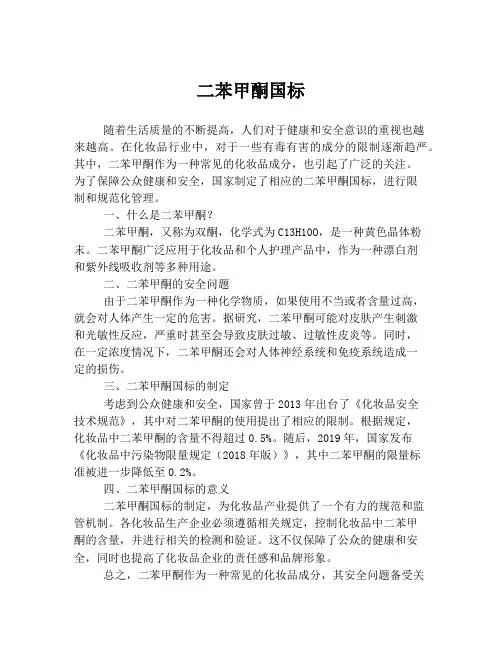
二苯甲酮国标随着生活质量的不断提高,人们对于健康和安全意识的重视也越来越高。
在化妆品行业中,对于一些有毒有害的成分的限制逐渐趋严。
其中,二苯甲酮作为一种常见的化妆品成分,也引起了广泛的关注。
为了保障公众健康和安全,国家制定了相应的二苯甲酮国标,进行限制和规范化管理。
一、什么是二苯甲酮?二苯甲酮,又称为双酮,化学式为C13H10O,是一种黄色晶体粉末。
二苯甲酮广泛应用于化妆品和个人护理产品中,作为一种漂白剂和紫外线吸收剂等多种用途。
二、二苯甲酮的安全问题由于二苯甲酮作为一种化学物质,如果使用不当或者含量过高,就会对人体产生一定的危害。
据研究,二苯甲酮可能对皮肤产生刺激和光敏性反应,严重时甚至会导致皮肤过敏、过敏性皮炎等。
同时,在一定浓度情况下,二苯甲酮还会对人体神经系统和免疫系统造成一定的损伤。
三、二苯甲酮国标的制定考虑到公众健康和安全,国家曾于2013年出台了《化妆品安全技术规范》,其中对二苯甲酮的使用提出了相应的限制。
根据规定,化妆品中二苯甲酮的含量不得超过0.5%。
随后,2019年,国家发布《化妆品中污染物限量规定(2018年版)》,其中二苯甲酮的限量标准被进一步降低至0.2%。
四、二苯甲酮国标的意义二苯甲酮国标的制定,为化妆品产业提供了一个有力的规范和监管机制。
各化妆品生产企业必须遵循相关规定,控制化妆品中二苯甲酮的含量,并进行相关的检测和验证。
这不仅保障了公众的健康和安全,同时也提高了化妆品企业的责任感和品牌形象。
总之,二苯甲酮作为一种常见的化妆品成分,其安全问题备受关注。
有关部门的二苯甲酮国标的制定,为化妆品行业提供了涉及健康安全的有力规范,并确保了化妆品生产企业的正常运营和消费者的合法权益。
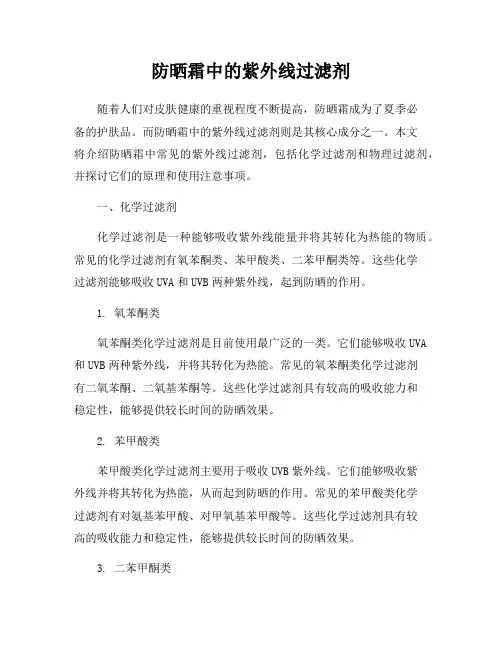
防晒霜中的紫外线过滤剂随着人们对皮肤健康的重视程度不断提高,防晒霜成为了夏季必备的护肤品。
而防晒霜中的紫外线过滤剂则是其核心成分之一。
本文将介绍防晒霜中常见的紫外线过滤剂,包括化学过滤剂和物理过滤剂,并探讨它们的原理和使用注意事项。
一、化学过滤剂化学过滤剂是一种能够吸收紫外线能量并将其转化为热能的物质。
常见的化学过滤剂有氧苯酮类、苯甲酸类、二苯甲酮类等。
这些化学过滤剂能够吸收UVA和UVB两种紫外线,起到防晒的作用。
1. 氧苯酮类氧苯酮类化学过滤剂是目前使用最广泛的一类。
它们能够吸收UVA 和UVB两种紫外线,并将其转化为热能。
常见的氧苯酮类化学过滤剂有二氧苯酮、二氧基苯酮等。
这些化学过滤剂具有较高的吸收能力和稳定性,能够提供较长时间的防晒效果。
2. 苯甲酸类苯甲酸类化学过滤剂主要用于吸收UVB紫外线。
它们能够吸收紫外线并将其转化为热能,从而起到防晒的作用。
常见的苯甲酸类化学过滤剂有对氨基苯甲酸、对甲氧基苯甲酸等。
这些化学过滤剂具有较高的吸收能力和稳定性,能够提供较长时间的防晒效果。
3. 二苯甲酮类二苯甲酮类化学过滤剂主要用于吸收UVA紫外线。
它们能够吸收紫外线并将其转化为热能,从而起到防晒的作用。
常见的二苯甲酮类化学过滤剂有二苯甲酮、二苯甲酮-4,4'-二甲基等。
这些化学过滤剂具有较高的吸收能力和稳定性,能够提供较长时间的防晒效果。
二、物理过滤剂物理过滤剂是一种能够反射和散射紫外线的物质。
常见的物理过滤剂有氧化锌和二氧化钛。
这些物理过滤剂能够反射和散射UVA和UVB 两种紫外线,起到防晒的作用。
物理过滤剂具有以下优点:不会被皮肤吸收,对皮肤刺激小,适合敏感肌肤;具有较高的稳定性,不易分解;能够立即起到防晒作用,不需要等待一段时间。
然而,物理过滤剂也存在一些缺点:容易在皮肤上形成白色残留物,影响美观;防晒效果相对较短,需要经常补涂。
三、使用注意事项1. 选择适合自己肤质和需求的防晒霜。
不同肤质和需求的人群可以选择不同的防晒霜,如干性肌肤可选择含有保湿成分的防晒霜,油性肌肤可选择质地清爽的防晒霜。
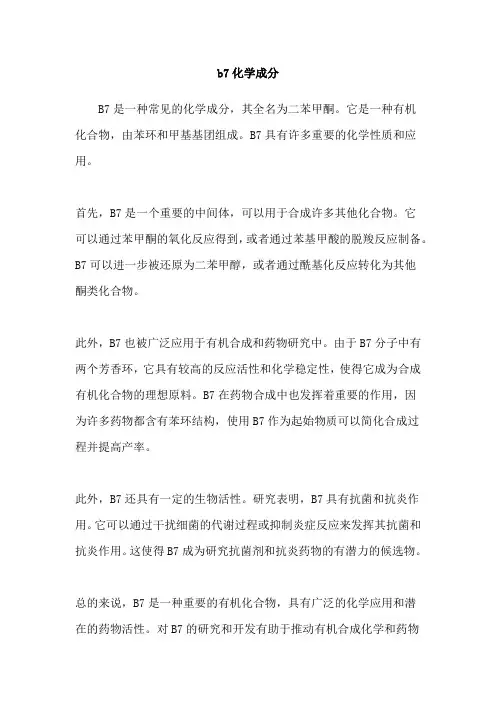
b7化学成分
B7是一种常见的化学成分,其全名为二苯甲酮。
它是一种有机
化合物,由苯环和甲基基团组成。
B7具有许多重要的化学性质和应用。
首先,B7是一个重要的中间体,可以用于合成许多其他化合物。
它
可以通过苯甲酮的氧化反应得到,或者通过苯基甲酸的脱羧反应制备。
B7可以进一步被还原为二苯甲醇,或者通过酰基化反应转化为其他
酮类化合物。
此外,B7也被广泛应用于有机合成和药物研究中。
由于B7分子中有两个芳香环,它具有较高的反应活性和化学稳定性,使得它成为合成有机化合物的理想原料。
B7在药物合成中也发挥着重要的作用,因
为许多药物都含有苯环结构,使用B7作为起始物质可以简化合成过
程并提高产率。
此外,B7还具有一定的生物活性。
研究表明,B7具有抗菌和抗炎作用。
它可以通过干扰细菌的代谢过程或抑制炎症反应来发挥其抗菌和抗炎作用。
这使得B7成为研究抗菌剂和抗炎药物的有潜力的候选物。
总的来说,B7是一种重要的有机化合物,具有广泛的化学应用和潜
在的药物活性。
对B7的研究和开发有助于推动有机合成化学和药物
研究的进展。
二苯甲酮的脑保护作用研究及临床应用前景引言:脑功能损伤是一种常见的临床问题,给患者和家属带来了巨大的痛苦和负担。
寻找有效的脑保护方法已成为当前研究的热点之一。
二苯甲酮是一种被广泛研究的药物,其在脑保护方面表现出了潜在的应用价值。
本文将探讨二苯甲酮的脑保护作用研究以及其在临床上的应用前景。
二苯甲酮的脑保护作用研究:1. 抗氧化作用:二苯甲酮已被证实具有较强的抗氧化作用,能够清除体内自由基,减少氧化应激对脑细胞的损伤。
研究发现,二苯甲酮能够显著降低大鼠脑组织内过氧化物酶水平,提高谷胱甘肽过氧化物酶活性,从而保护脑细胞免受氧化损伤。
2. 抗炎作用:炎症反应在脑组织损伤后起着重要作用。
二苯甲酮具有抑制炎症反应的作用,通过抑制炎性细胞因子的产生,减轻炎症反应引起的脑组织损伤。
实验研究表明,二苯甲酮可以显著降低大鼠脑组织中白细胞浸润和炎性细胞因子的表达,减轻炎症反应带来的细胞损伤。
3. 抗神经元凋亡作用:神经元凋亡在脑损伤过程中发挥重要作用。
二苯甲酮能够通过调节凋亡相关蛋白的表达,抑制神经元凋亡的发生。
研究发现,二苯甲酮可显著降低大鼠脑组织中Bax和caspase-3的表达,提高Bcl-2的表达水平,从而减少神经元死亡。
4. 促进神经再生作用:二苯甲酮还被发现具有促进神经再生的作用。
实验研究表明,二苯甲酮能够促进脑组织中GAP-43蛋白的表达,从而增加轴突的生长和神经再生,有助于受损神经细胞的修复。
二苯甲酮的临床应用前景:1. 缺血性脑卒中:缺血性脑卒中是导致脑功能损伤的主要原因之一。
临床研究表明,二苯甲酮能够通过抑制炎症反应和氧化应激,减少神经元凋亡和保护神经功能,从而在缺血性脑卒中的治疗中发挥积极作用。
2. 脑损伤后的认知功能障碍:脑损伤后往往伴随着认知功能障碍,给患者的康复带来了很大的困扰。
研究发现,二苯甲酮可以通过抗氧化和抗炎作用,保护脑细胞免受进一步损伤,减轻脑损伤后的认知功能障碍。
3. 神经退行性疾病:神经退行性疾病是一类以神经细胞凋亡为主要特征的疾病,如阿尔茨海默病和帕金森病等。
二苯甲酮的制备方法
在250mL四口烧瓶上,分别装置电动搅拌器、温度计、滴液漏斗及冷凝管。
在冷凝管的上端装一个氯化钙干燥管,在干燥管的上端用橡皮管连接一个玻璃漏斗,后者放于盛水的烧杯中,使漏斗圆口距烧杯内水面lcm,以便吸收反应过程中生成的氯化氢气体。
在四口烧瓶中放入39g(0.5mol)无水苯、14g(0.1mol)充分研碎的无水氯化铝。
在滴液漏斗中放置14g(0.1mol)苯甲酰氯。
在搅拌下缓缓滴加苯甲酰氯使之反应不过分剧烈。
苯甲酰氯滴加完后,在水浴上加热至50℃,直至无氯化氢逸出为止。
然后将反应物倒入。
100mL冰水中,加l0mL浓盐酸使析出的沉淀溶解。
分出苯层,先后用30mL水、30ml5%的氢氧化钠和30ml水洗涤。
分出苯层后,用无水硫酸镁干燥,常压蒸馏回收苯,减压蒸馏收集170~175℃/2kPa的馏分,得产品。
二苯甲酮的用途:
二苯甲酮是紫外线吸收剂、有机颜料、医药、香料、杀虫剂的中间体。
医药工业中用于生产双环己哌啶、苯甲托品氢溴酸盐、苯海拉明盐酸盐等。
本品本身也是苯乙烯聚合抑制剂和香料定香剂。
能赋予香精以甜的气息,用在多种香水和皂用香精中。
可用于调配杏仁、桃子、奶油、椰子等食用香精。
在最终加香食品中的建议用量为0.5~2.4mg/kg。
二苯甲酮标准hgt5887二苯甲酮是一种有机化合物,化学式为C13H10O,是一种无色结晶体。
它具有强烈的芳香味和刺激性气味。
二苯甲酮在化工、医药、香料等领域有着广泛的应用。
本文将从二苯甲酮的制备、性质、用途等方面进行阐述。
首先,二苯甲酮的制备方法有多种。
其中,较常见的一种方法是苯乙酸经羧酸酯缩合反应制备。
具体步骤为:首先将苯乙酸与无水乙醇反应生成苯乙酸乙酯,然后在硫酸催化下与甲醇反应生成苯乙酸甲酯。
随后,将苯乙酸甲酯与三氯化铝催化剂反应,得到二苯甲酮。
该方法的反应条件较为温和,具有较高的产率和选择性。
二苯甲酮是一种结晶性固体,具有较高的熔点和沸点。
它可以溶于有机溶剂如醚、丙酮和苯等,但几乎不溶于水。
此外,二苯甲酮的结晶形式多种多样,常见的有棱柱状和片状晶体。
二苯甲酮还可以发生不同的光致发色反应,这也为其在染料和光学器件领域的应用提供了可能。
二苯甲酮在医药领域有着重要的应用。
研究表明,二苯甲酮具有抗菌、抗病毒和抗癌活性。
一些研究还发现,二苯甲酮具有抗氧化和抗炎作用,可用于治疗一些炎症相关的疾病。
此外,二苯甲酮还可以作为血红素的抗氧化剂,具有一定的保健作用。
在化工领域,二苯甲酮是一种重要的中间体,用于制备其他化合物。
例如,二苯甲酮可用作制备香精和香料的原料。
此外,二苯甲酮还可以用于制备染料、荧光物质和光学亮剂等。
这些产品在纺织、塑料、造纸和印刷等行业有着广泛的应用。
总的来说,二苯甲酮是一种重要的有机化合物,具有广泛的应用前景。
它在医药、化工和香料等领域都有着重要的应用。
二苯甲酮的制备方法多样,可以通过酯缩合反应来合成。
其物理性质稳定,有较高的熔点和沸点,并且可以溶于多种有机溶剂。
由于其多样的结晶形态和光致发色反应,二苯甲酮在染料和光学器件领域也具有潜在的应用。
二苯甲酮的研究仍在不断深入,相信随着科学技术的进步,它的应用领域还将继续扩大。
2024年二苯甲酮市场发展现状引言二苯甲酮(Benzophenone)是一种常见的有机化合物,广泛应用于光敏剂、紫外吸收剂、光聚合剂等领域。
本文将介绍二苯甲酮市场的发展现状,包括市场规模、应用领域、市场竞争情况等。
市场规模二苯甲酮市场在过去几年内持续增长。
根据市场研究报告,2019年二苯甲酮全球市场规模达到X万吨,预计未来几年将保持稳定增长。
这主要受到二苯甲酮在不同行业中的广泛应用所推动。
应用领域光敏剂行业二苯甲酮在光敏剂行业中广泛用于印刷、油墨、制版等领域。
光敏剂是一种能吸收光能并转化为化学能的物质,二苯甲酮作为光敏剂的一种,具有高效的能量转换性能和较长的寿命,被广泛应用于光敏剂市场。
紫外吸收剂行业二苯甲酮是一种优良的紫外吸收剂,可以有效吸收紫外线,并转化为无害的热能,从而保护产品免受紫外线的伤害。
因此,二苯甲酮在化妆品、塑料、涂料等领域中被广泛应用作为紫外吸收剂。
光聚合剂行业二苯甲酮在光聚合剂行业中也有着重要的应用。
光聚合剂是一种利用光能引发聚合反应的物质,可以在短时间内实现快速固化。
二苯甲酮在光聚合剂中可作为引发剂,通过吸收光能来引发聚合反应,从而提高产品的生产效率。
市场竞争情况二苯甲酮市场竞争激烈,主要厂商包括ABC公司、DEF公司和GHI公司等。
这些厂商在产品质量、技术创新和价格竞争等方面展开竞争。
此外,市场还存在一些中小型企业,通过开发特殊规格和应用领域来寻找市场的细分空间。
市场前景与挑战二苯甲酮市场具有较大的发展前景。
随着各行业对高性能添加剂的需求不断增加,二苯甲酮作为一种多功能的化合物,将有更广泛的应用空间。
然而,市场也面临一些挑战,例如原材料价格波动、环保要求的提高等,这将对市场的发展带来一定的影响。
结论二苯甲酮市场在过去几年内取得了显著的发展,主要受到其在光敏剂、紫外吸收剂和光聚合剂等行业中的广泛应用推动。
市场规模不断扩大,竞争形势日益激烈。
然而,市场前景较为乐观,随着各行业对高性能添加剂的需求增加,二苯甲酮市场有望继续保持稳定发展。
二苯甲酮显色原理引言:二苯甲酮(Benzoin)是一种有机化合物,具有强烈的香草味。
它在化学实验室中广泛应用于有机合成和分析化学中。
二苯甲酮的显色原理是指在特定条件下,二苯甲酮会发生化学反应,产生有色物质从而产生显色现象。
本文将介绍二苯甲酮显色原理以及其在实验室中的应用。
一、二苯甲酮的结构与性质二苯甲酮的分子式为C14H12O,它由苯甲醇经过酸催化氧化反应得到。
二苯甲酮是一种白色结晶固体,在常温下稳定。
它是一种非常有用的化合物,可以用作酮类化合物的合成试剂,也可以用作荧光染料和光敏化合物。
二、二苯甲酮显色原理二苯甲酮显色原理是指在还原剂的作用下,二苯甲酮会发生还原反应,生成有色的产物。
这种显色反应被广泛应用于分析化学中,可以用于测定还原剂的含量以及其他化合物的定量分析。
三、二苯甲酮显色的实验操作在实验室中,可以通过以下步骤进行二苯甲酮显色实验:1. 准备试剂:将适量的二苯甲酮溶解在有机溶剂中,并配制出一定浓度的溶液。
2. 加入还原剂:将所需测定的样品溶液与还原剂混合,在适当的温度下反应一段时间。
3. 观察显色现象:反应完成后,观察产物的颜色变化并记录下来。
4. 分析测定:根据显色的程度可以确定还原剂的含量或其他化合物的浓度。
四、二苯甲酮显色的应用二苯甲酮显色原理在实验室中有着广泛的应用。
以下是几个典型的应用案例:1. 还原剂的测定:二苯甲酮可以作为指示剂,用于测定还原剂的含量。
通过比较产物的颜色与标准曲线,可以确定还原剂的浓度。
2. 金属离子的测定:某些金属离子(如铜离子)可以还原二苯甲酮,产生有色产物。
通过测定产物的颜色可以确定金属离子的浓度。
3. 分子结构的研究:二苯甲酮显色原理可以用于研究有机分子的结构和反应机理。
通过观察显色现象可以推断出分子内部的电子转移过程和还原机制。
结论:二苯甲酮显色原理是一种重要的化学反应原理,在实验室中有着广泛的应用。
通过二苯甲酮的显色反应,可以确定还原剂的含量、金属离子的浓度以及研究分子结构和反应机理。
二苯甲酮的熔点
二苯甲酮是一种有机化合物,化学式为C13H10O,它是一种
白色晶体,常用于有机合成反应中。
二苯甲酮的熔点是多少呢?这是一个非常常见的问题,下面我们来详细了解一下。
首先,二苯甲酮的熔点是指在标准大气压下,二苯甲酮从固态转化为液态时的温度。
根据实验数据,二苯甲酮的熔点约为
94-96℃。
但是需要注意的是,由于各种因素的影响,不同实
验条件下得到的熔点可能会有所不同。
那么,为什么需要知道二苯甲酮的熔点呢?这是因为在有机合成中,熔点可以作为判断化合物纯度的重要指标之一。
通常情况下,纯度高的化合物熔点会比较高,而杂质含量较高的化合物熔点则会降低或出现熔点范围。
在实验室中,通常会通过测量化合物的熔点来判断其纯度。
具体方法是将待测化合物装入玻璃管中,加热至接近熔点时开始记录温度,并在化合物完全融化时停止记录。
通过与已知熔点的对比,可以初步判断化合物的纯度。
除了作为纯度判断指标外,二苯甲酮还有许多其他用途。
例如,它可以作为有机合成反应中的重要原料或催化剂;也可以用于染料、医药等领域。
总之,二苯甲酮是一种重要的有机化合物,在有机合成、医药等领域都有广泛的应用。
了解其熔点对于相关实验和应用都具有重要意义。
Benzophenone Ketyl StudyI. IntroductionA. BackgroundThe benzophenone/sodium still is a widely used method to produce water, oxygen, and peroxide free solvents for organic synthesis.1,2 Most organic labs routinely use this method to dry their solvents that are used in moisture sensitive reactions. The most popular solvent for these reactions is tetrahydrofuran. However, despite widespread use there is no information available in the literature on how dry or oxygen free the solvent really is from this method. At Mallinckrodt Baker R&D we have developed a process to produce Ultra dry THF (less than 10 ppm water and peroxides), a study was initiated to compare our new material with material produced from the benzophenone/sodium still.B. Benzophenone/Sodium StillA literature search on the benzophenone/sodium still found only one reference to date on the subject.1 The reference was from Chemical and Engineering News in 1978.1 The procedure in the article describes adding 5 grams of sodium, and 30 grams of benzophenone to 3 liters of tetrahydrofuran.1 The mixture is then refluxed under inert gas until the blue color of the benzophenone ketyl forms. The author of the article states that "once the blue color forms, distillation of the solvent will yield very pure, dry, oxygen and hydroperoxide free ether."1 However, the author provides no data on the purity or water level of the solvent produced from this method. We decided to carry out a study on the benzophenone/sodium still to obtain these answers.II. Results and DiscussionA. Benzophenone/Ketyl THF Still Purity StudyWe set up a THF still following the exact procedure as in Chemical and Engineering News reference.1 Analysis of the THF produced from the still gave 10.1 ppm of water with no dissolved oxygen or hydroperoxides. The GC analysis of the tetrahydrofuran from the still found that it contained 150 ppm of benzene as an impurity. A study was initiated to determine the source of the benzene. We tested both the tetrahydrofuran, and benzophenone starting material and found no benzene present. This indicated that the source of the benzene was from the chemical breakdown of the benzophenone in the still. A GC/MS analysis of the THF sodium/benzophenone mixture was carried out to help determine the possible mechanism of benzene formation. The GC/MS analysis showed compounds such as 1, 2, 3, and 4.These compounds are formed by some type of free radical reaction with phenyl radicals. The probable mechanism is the carbonyl phenyl group bond breaks forming phenyl radicals, and benzaldehyde. The benzaldehyde (5) then either undergoes reduction to benzyl alcohol (6), or further reaction with the phenyl free radicals.We carried out a test to determine if the benzaldehyde is reduced in thesodium/benzophenone still. Benzaldehyde (5) was added to THF in the presence of sodium, the mixture was then refluxed. We found that benzaldehyde (5) was reduced to the benzyl alcohol (6). Additional further GC/MS analysis was carried out to look for the benzaldehyde (5) and benzyl alcohol (6). Unfortunately, neither benzyl alcohol nor benzaldehyde was detected. One possible explanation is the benzaldehyde and benzyl alcohol rapidly undergo further reactions in the sodium/benzophenone still to prevent their detection. For example, the reaction of benzaldehyde with phenyl radicals could have resulted in the formation of compounds (1), and (2). Another possible pathway would be rapid polymerization of these compounds.B. Effect of Water on the Benzophenone KetylThe next study was to determine what effect water had on the decomposition of the benzophenone ketyl. The benzophenone ketyl was produced in THF at a concentration of 630 ppm. The loss of blue color would indicate decomposition of the ketyl. Titration of the ketyl with water showed that a full 100 mol% of water was required to quench the blue color. Thisindicates that water reacts in a simple one to one mole ratio with the ketyl. Therefore, the blue color of the ketyl does not necessary indicate super dry conditions.For example in the typical procedure the ketyl is produced at a concentration of 6311 ppm in THF. When a small amount of water is added to a sample of this mixture to increase the water concentration, the solution will still remain blue since until all of the ketyl decomposed. Thus it would be possible to have a concentration of 100 ppm water in the solvent, and if the ketyl was not used up, it would still have the blue ketyl color.C. Effect of Oxygen on Benzophenone KetylThe final study was to determine how sensitive the ketyl was to oxygen. An experiment was carried out where the ketyl was titrated with oxygen. We found that the color was quenched with 8 mole% of oxygen. This data shows that the benzophenone ketyl reacts catalytically with oxygen and not on a one to one mole ratio as water does. Thus the benzophenone ketyl is much more sensitive to oxygen than to water.II. ConclusionDrying and purification of THF and other solvents is a widely used practice in many labs. Solvent produced from the sodium/benzophenone still is believed to be of the highest quality. Despite the fact there was no real data on the actual quality of the solvent. This belief has been passed down from lab worker to lab worker as the method of choice for producing anhydrous solvents for organometallic synthesis. Our studies have shown that while the THF produced from the still is free of oxygen and low in water (10 ppm), it does contain benzene contamination. The presence of benzene could interfere with critical applications. Additionally, the blue color of the benzophenone ketyl is not a very reliable indication of anhydrous conditions. These results are very significant since they provide the chemist real information on the purity of the tetrahydrofuran produced from the sodium/benzophenone still. In contrast our new THF is oxygen free, contains less that 5 ppm of peroxides. Our water content is less than 10 ppm and our material is free of impurities such as benzene. This material is available in bottles and CYCLE-TAINERs in sizes up to 215L.III. References1. Schwartz, A.M. Chem. Eng. News 1978, (56) 24, 88.2. Perrin, D.D.; Armarego, W.L.F "Purification Of Laboratory Chemicals" Pergamon Press: New York, 1980.© 2000 by Mallinckrodt Baker Inc. All Rights Reserved.Literature # 8882R (2/99)。